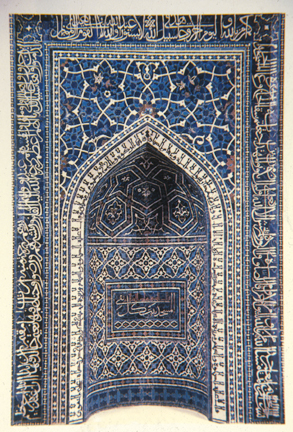
Mosaic Mihrab from the Madrasa Imami (Restored), Isfahan, 11'3" x 7'6", 1354 CE
ART 198 - HISTORY OF WORLD CERAMICS
| This mosaic mihrab (prayer niche) from the Madrasa Imami (school for advanced study by Imams) has been restored in its location in the ancient capital of Isfahan, in Persia. It is made of glazed and painted ceramic on plaster using a painstaking process of cutting each piece of tile, including the pieces that make up the kufic inscription around the frame of the niche. Each niche would have had a copy of the Koran for reciting verses, and each was oriented to face Mecca for daily prayers and meditations. The use of a rich cobalt blue underglaze is evident. Persia has always been a rich source of raw cobalt, and this material was traded throughout the region and into China. Such architectural elements would travel with the spread of Islam across Northern Africa and into Spain, and can be seen in throughout Andalusia (Southern Spain) in mosques in cities such as Granada, Ronda, Malaga, Cordoba, and Seville. | Mosaic Mihrab from the Madrasa Imami (Restored), Isfahan, 11'3" x 7'6", 1354 CE |
|
|